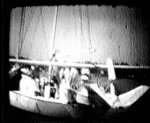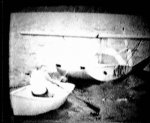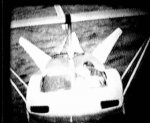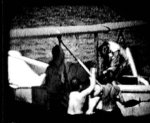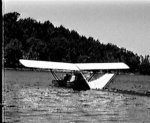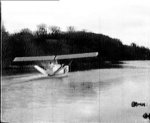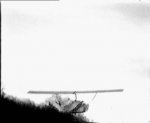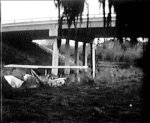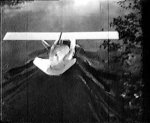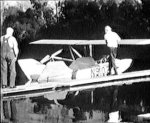Очень интересный гидросамолёт, управление - подвижным крылом.

Я никак не связан с нынешним владельцем чертежей (Bill Wolfe) коммерческими интересами, но о покупке чертежей с ним переписывался. Он отправляет документацию со страховкой, принимает в оплату вестерн и манигрэм 😀, поэтому цена материалов будет несколько больше, но в пределах разумного.
Билл позволил разместить здесь историю этого самолёта в его изложении.
/me
I first met George G. Spratt in 1969 when fellow engineers at Boeing Philadelphia invited me to join them on the Chesapeake Bay to see the Spratt Controlwing. At that time I had never heard of it.
My first view of the aircraft was from a small dinghy George brought to shore to take visitors out to his home-built 55 foot, arc welded steel personal aircraft carrier, anchored over a large shallow spot in the middle of the Bay to demonstrate his prototype Controlwing flying boat N910Z.
This aircraft was flown by over 100 pilots in the 60s and 70s, including me, for several hundred accident free hours. It was the most often seen model shown in many magazines. Most new pilots loved it but old timers did not care for it much since no stunts were possible with such a stable aircraft.
I built my first 85 HP Mercury powered, all wood Spratt model 107 flying boat in the late 90s. In 2000 my flight medical expired just as I started flight testing. I only made a few short hops before selling it as no other test pilot was available.
The Tampa buyer claimed he was going to build kits but only used the hull as a claimed 75 mph runabout. It was re-sold it to a Norfolk man who never actually flew it. If I could swing it, I would buy it back and donate it to the smithsonian.
Last year I started another Spratt flying boat incorporating some hull mods and planned to use a 120 HP, liquid cooled VW but at age 83 I ran out of steam and money before I was almost ready to install the engine. A friend in Orlando is completing it and hopes to have it ready for the very first public demonstrations ever made for a Controlwing by winter.
He and Florida friends are seriously considering a Controlwing kit development next.
The Spratt Controlwing flying boat is a favorite subject of mine ever since I first saw and flew the 60 HP Mercury powered prototype N910Z in 1969. I built my first 85 HP Mercury powered Controlwing flying boat N107GW in the 90s. I have been a strong advocate to keep this kinder, gentler and safer aircraft design.
I was building a second Controlwing flying boat using a 120 HP liquid cooled VW engine which is now being completed by friends in Florida. This particular aircraft is intended to be shown at major air shows for the aviation community and the general public to see one for the very first time. After public demonstrations the development of a Controlwing flying boat kit is expected to get underway.
Surprisingly the name Spratt and the Controlwing is still not very widely known to people both inside and outside of the aviation community. Spratt’s 200#, Evinrude powered ultralight roadable Controlwing was shown in the August 1936 Popular Science magazine and the Spratt/Stout flying Automobile in the June 1945 Popular Mechanics, “The Brain Behind the Wrights” in the January 1962 Climax Magazine, the Spratt Controlwing flying boat was the cover article for both the June 1962 Popular Mechanics magazine and the April 1970 Science and Mechanics magazine and also in the September 1969 AOPA Pilot magazine. The Experimental Aircraft Association’s 'Sport Aviation' magazine had Controlwing articles in the July 1972, December 1973, June and July 1974, May 1976 and May 1980 and in the April 2000 Experimenter magazine. The Smithsonian’s December ‘94/ January ’95 Air and Space magazine had a Controlwing article and my aircraft was shown several times in later EAA publications.
A film was recently prepared for the Smithsonian Network covering early aviation and experimental aircraft including Spratt Controlwing aircraft.
I knew and often visited George G. Spratt as a personal friend for 29 years. He was a visionary aeronautical engineer, inventor and a true gentleman.
There were two Spratt Controlwing flying boats flying in the Chesapeake Bay area during the mid 60's to mid 70's accumulating hundreds of accident free hours, and soloed by over 100 pilots who only had to ask. The sole Spratt Controlwing Subaru powered land plane prototype is now in the Mid Atlantic Air Museum at Reading, PA. A Rotax powered ultralight with a single rubber float was built but never fully developed.
My Spratt Controlwing flying boat N107GW was only the third plans-built flying boat to be completed and flown up to now as far as the late George G. Spratt and I knew. All three were built primarily of wood rather than the all composite construction like the prototype N910Z. Of the other two, both using VW engines, one was lost in a water collision and the other one may be deteriorating in Florida. N107GW is the only Spratt Controlwing aircraft in the current FAA registry. I have been told that Controlwings have been seen in Canada.
Dr. George A. Spratt, a 1885 medical school graduate, developed a serious heart condition preventing him from practicing medicine so he took an interest in aerodynamics and became a close friend of Octave Chanute. They both realized that since liftoff was easily attained, they concentrated their developments and experiments in the very important and more difficult area of stability and control. Spratt made extensive observations of the wings of birds and bees and insects to develope his early elementary understanding of nature's subtle solutions to the stability and control of flying creatures which is now commonly known to the public due to high speed photography.
Chanute and Spratt were intrigued by the efforts of Wilbur and Orville Wright and offered their free assistance. Dr. Spratt visited them at Kitty Hawk frequently and eventually became their primary aeronautical consultant. After introducing them to his own elaborate wind tunnel that measured both lift and drag, they were later able to copy his wind tunnel and use it for some of their experiments including a very effective propeller development.
The Wrights have been given much undue credit as single-handedly developing the first successful powered aircraft, but Spratt's volunteer technical assistance and design changes played a significant part in their ultimate success. He is rarely mentioned in history books and then only as a casual visiting fisherman. A Wright employee built their engines from scratch, they were fortunate to have a supportive family, an established business from which they could take time off, had the use of that facility to develop their aircraft and neither one ever married. These two totally dedicated brothers had little social life to speak of.
Chanute and Spratt did not agree with the Wright's complicated three control approach and suggested simpler Controlwing design features which they rejected but Spratt helped them do it their way anyway. Spratt and Chanute later delivered a large Controlwing glider of their own design to Kitty Hawk. It was successfully flown and offered it to the Wright's for continued testing but they abandoned it to the weather.
Had they continued testing it, aviation history may have been quite different and tens of thousands of lives would have been saved. They believed elaborate pilot training was better than having the built-in stability and safety features found in the Controlwing designs.
Wilbur and Orville were more than willing to accept Spratt's volunteer technical assistance but were not willing to share their celebrity or any potential financial gains. They rarely acknowledged him or his important design changes which helped lead to their ultimate success, however they never hesitated to call upon him as an expert witness for many patent suites years later. It took fourteen years for Dr. Spratt to get his own Controlwing related patents because the patent office officials consistently could not understand such a different concept from other existing aircraft. See the web site www.georgespratt.org for more of the interesting Spratt/Wright connection and other information.
Dr. Spratt, and with his son the late George G. Spratt, built twenty different gliders, seaplanes and land planes. Each one incorporated a Controlwing in some fashion, including a successful flying automobile developed in conjunction with Bill Stout which was seriously considered for production by Convair and a smaller land plane developed for Bendix but not pursued as management elected not to compete with their customers.
In 1936 George G. Spratt was flying his 200 # Evinrude powered, roadable ultralight Controlwing! I suspect many people believe ultralights are a new and modern idea. To view this aircraft in operation, see “Aeronautical Oddities”, an Experimental Aircraft Association video of older and unusual flying machines.
Я никак не связан с нынешним владельцем чертежей (Bill Wolfe) коммерческими интересами, но о покупке чертежей с ним переписывался. Он отправляет документацию со страховкой, принимает в оплату вестерн и манигрэм 😀, поэтому цена материалов будет несколько больше, но в пределах разумного.
Билл позволил разместить здесь историю этого самолёта в его изложении.
/me
I first met George G. Spratt in 1969 when fellow engineers at Boeing Philadelphia invited me to join them on the Chesapeake Bay to see the Spratt Controlwing. At that time I had never heard of it.
My first view of the aircraft was from a small dinghy George brought to shore to take visitors out to his home-built 55 foot, arc welded steel personal aircraft carrier, anchored over a large shallow spot in the middle of the Bay to demonstrate his prototype Controlwing flying boat N910Z.
This aircraft was flown by over 100 pilots in the 60s and 70s, including me, for several hundred accident free hours. It was the most often seen model shown in many magazines. Most new pilots loved it but old timers did not care for it much since no stunts were possible with such a stable aircraft.
I built my first 85 HP Mercury powered, all wood Spratt model 107 flying boat in the late 90s. In 2000 my flight medical expired just as I started flight testing. I only made a few short hops before selling it as no other test pilot was available.
The Tampa buyer claimed he was going to build kits but only used the hull as a claimed 75 mph runabout. It was re-sold it to a Norfolk man who never actually flew it. If I could swing it, I would buy it back and donate it to the smithsonian.
Last year I started another Spratt flying boat incorporating some hull mods and planned to use a 120 HP, liquid cooled VW but at age 83 I ran out of steam and money before I was almost ready to install the engine. A friend in Orlando is completing it and hopes to have it ready for the very first public demonstrations ever made for a Controlwing by winter.
He and Florida friends are seriously considering a Controlwing kit development next.
The Spratt and Controlwing Flying Boat History
The Spratt Controlwing flying boat is a favorite subject of mine ever since I first saw and flew the 60 HP Mercury powered prototype N910Z in 1969. I built my first 85 HP Mercury powered Controlwing flying boat N107GW in the 90s. I have been a strong advocate to keep this kinder, gentler and safer aircraft design.
I was building a second Controlwing flying boat using a 120 HP liquid cooled VW engine which is now being completed by friends in Florida. This particular aircraft is intended to be shown at major air shows for the aviation community and the general public to see one for the very first time. After public demonstrations the development of a Controlwing flying boat kit is expected to get underway.
Surprisingly the name Spratt and the Controlwing is still not very widely known to people both inside and outside of the aviation community. Spratt’s 200#, Evinrude powered ultralight roadable Controlwing was shown in the August 1936 Popular Science magazine and the Spratt/Stout flying Automobile in the June 1945 Popular Mechanics, “The Brain Behind the Wrights” in the January 1962 Climax Magazine, the Spratt Controlwing flying boat was the cover article for both the June 1962 Popular Mechanics magazine and the April 1970 Science and Mechanics magazine and also in the September 1969 AOPA Pilot magazine. The Experimental Aircraft Association’s 'Sport Aviation' magazine had Controlwing articles in the July 1972, December 1973, June and July 1974, May 1976 and May 1980 and in the April 2000 Experimenter magazine. The Smithsonian’s December ‘94/ January ’95 Air and Space magazine had a Controlwing article and my aircraft was shown several times in later EAA publications.
A film was recently prepared for the Smithsonian Network covering early aviation and experimental aircraft including Spratt Controlwing aircraft.
I knew and often visited George G. Spratt as a personal friend for 29 years. He was a visionary aeronautical engineer, inventor and a true gentleman.
There were two Spratt Controlwing flying boats flying in the Chesapeake Bay area during the mid 60's to mid 70's accumulating hundreds of accident free hours, and soloed by over 100 pilots who only had to ask. The sole Spratt Controlwing Subaru powered land plane prototype is now in the Mid Atlantic Air Museum at Reading, PA. A Rotax powered ultralight with a single rubber float was built but never fully developed.
My Spratt Controlwing flying boat N107GW was only the third plans-built flying boat to be completed and flown up to now as far as the late George G. Spratt and I knew. All three were built primarily of wood rather than the all composite construction like the prototype N910Z. Of the other two, both using VW engines, one was lost in a water collision and the other one may be deteriorating in Florida. N107GW is the only Spratt Controlwing aircraft in the current FAA registry. I have been told that Controlwings have been seen in Canada.
Dr. George A. Spratt, a 1885 medical school graduate, developed a serious heart condition preventing him from practicing medicine so he took an interest in aerodynamics and became a close friend of Octave Chanute. They both realized that since liftoff was easily attained, they concentrated their developments and experiments in the very important and more difficult area of stability and control. Spratt made extensive observations of the wings of birds and bees and insects to develope his early elementary understanding of nature's subtle solutions to the stability and control of flying creatures which is now commonly known to the public due to high speed photography.
Chanute and Spratt were intrigued by the efforts of Wilbur and Orville Wright and offered their free assistance. Dr. Spratt visited them at Kitty Hawk frequently and eventually became their primary aeronautical consultant. After introducing them to his own elaborate wind tunnel that measured both lift and drag, they were later able to copy his wind tunnel and use it for some of their experiments including a very effective propeller development.
The Wrights have been given much undue credit as single-handedly developing the first successful powered aircraft, but Spratt's volunteer technical assistance and design changes played a significant part in their ultimate success. He is rarely mentioned in history books and then only as a casual visiting fisherman. A Wright employee built their engines from scratch, they were fortunate to have a supportive family, an established business from which they could take time off, had the use of that facility to develop their aircraft and neither one ever married. These two totally dedicated brothers had little social life to speak of.
Chanute and Spratt did not agree with the Wright's complicated three control approach and suggested simpler Controlwing design features which they rejected but Spratt helped them do it their way anyway. Spratt and Chanute later delivered a large Controlwing glider of their own design to Kitty Hawk. It was successfully flown and offered it to the Wright's for continued testing but they abandoned it to the weather.
Had they continued testing it, aviation history may have been quite different and tens of thousands of lives would have been saved. They believed elaborate pilot training was better than having the built-in stability and safety features found in the Controlwing designs.
Wilbur and Orville were more than willing to accept Spratt's volunteer technical assistance but were not willing to share their celebrity or any potential financial gains. They rarely acknowledged him or his important design changes which helped lead to their ultimate success, however they never hesitated to call upon him as an expert witness for many patent suites years later. It took fourteen years for Dr. Spratt to get his own Controlwing related patents because the patent office officials consistently could not understand such a different concept from other existing aircraft. See the web site www.georgespratt.org for more of the interesting Spratt/Wright connection and other information.
Dr. Spratt, and with his son the late George G. Spratt, built twenty different gliders, seaplanes and land planes. Each one incorporated a Controlwing in some fashion, including a successful flying automobile developed in conjunction with Bill Stout which was seriously considered for production by Convair and a smaller land plane developed for Bendix but not pursued as management elected not to compete with their customers.
In 1936 George G. Spratt was flying his 200 # Evinrude powered, roadable ultralight Controlwing! I suspect many people believe ultralights are a new and modern idea. To view this aircraft in operation, see “Aeronautical Oddities”, an Experimental Aircraft Association video of older and unusual flying machines.
